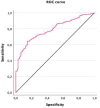Neuropsychological impairment in post-COVID condition individuals with and without cognitive complaints
- PMID: 36337708
- PMCID: PMC9631485
- DOI: 10.3389/fnagi.2022.1029842
Neuropsychological impairment in post-COVID condition individuals with and without cognitive complaints
Abstract
One of the most prevalent symptoms of post-COVID condition is cognitive impairment, which results in a significant degree of disability and low quality of life. In studies with large sample sizes, attention, memory, and executive function were reported as long-term cognitive symptoms. This study aims to describe cognitive dysfunction in large post-COVID condition individuals, compare objective neuropsychological performance in those post-COVID condition individuals with and without cognitive complaints, and identify short cognitive exams that can differentiate individuals with post-COVID symptoms from controls. To address these aims, the Nautilus project was started in June 2021. During the first year, we collected 428 participants' data, including 319 post-COVID and 109 healthy controls (18-65 years old) from those who underwent a comprehensive neuropsychological battery for cognitive assessment. Scores on tests assessing global cognition, learning and long-term memory, processing speed, language and executive functions were significantly worse in the post-COVID condition group than in healthy controls. Montreal Cognitive Assessment, digit symbol test, and phonetic verbal fluency were significant in the binomial logistic regression model and could effectively distinguish patients from controls with good overall sensitivity and accuracy. Neuropsychological test results did not differ between those with and without cognitive complaints. Our research suggests that patients with post-COVID conditions experience significant cognitive impairment and that routine tests like the Montreal Cognitive Assessment, digit symbol, and phonetic verbal fluency test might identify cognitive impairment. Thus, the administration of these tests would be helpful for all patients with post-COVID-19 symptoms, regardless of whether cognitive complaints are present or absent.
Study registration: www.ClinicalTrials.gov, identifiers NCT05307549 and NCT05307575.
Keywords: COVID-19; NeuroCOVID; cognitive function; neuropsychological test; post-COVID-19 condition.
Copyright © 2022 Ariza, Cano, Segura, Adan, Bargalló, Caldú, Campabadal, Jurado, Mataró, Pueyo, Sala-Llonch, Barrué, Bejar, Cortés, NAUTILUS-Project Collaborative Group, Junqué and Garolera.
Conflict of interest statement
The authors declare that the research was conducted in the absence of any commercial or financial relationships that could be construed as a potential conflict of interest.
Figures



References
-
- Allegri R. F., Mangone C. A., Villavicencio A. F., Rymberg S., Taragano F. E., Baumann D. (1997). Spanish boston naming test norms. Clin. Neuropsychol. 11 416–420. 10.1080/13854049708400471 - DOI
-
- Alviarez-Schulze V., Cattaneo G., Pachón-García C., Solana-Sánchez J., Tormos J. M., Pascual-Leone A., et al. (2022). Validation and normative data of the spanish version of the rey auditory verbal learning test and associated long-term forgetting measures in middle-aged adults. Front. Aging Neurosci. 14:809019. 10.3389/fnagi.2022.809019 - DOI - PMC - PubMed
-
- Ardila A., Ostrosky-Solís F., Bernal B. (2006). Cognitive testing toward the future: the example of semantic verbal fluency (ANIMALS). Int. J. Psychol. 41 324–332. 10.1080/00207590500345542 - DOI

